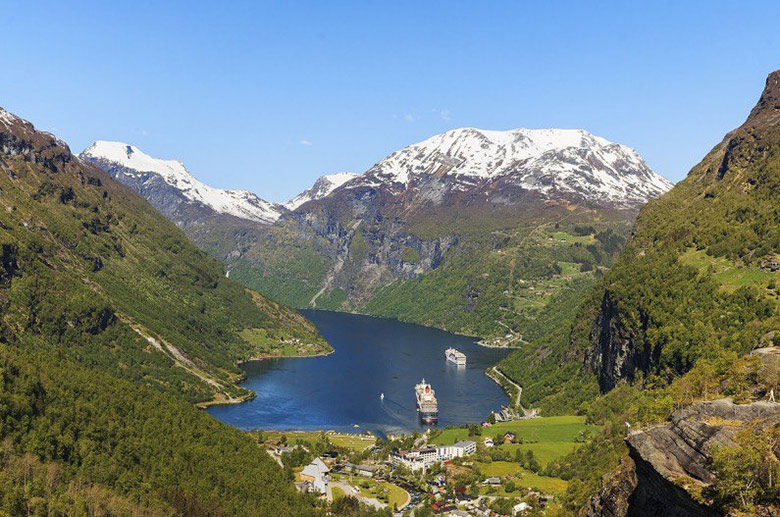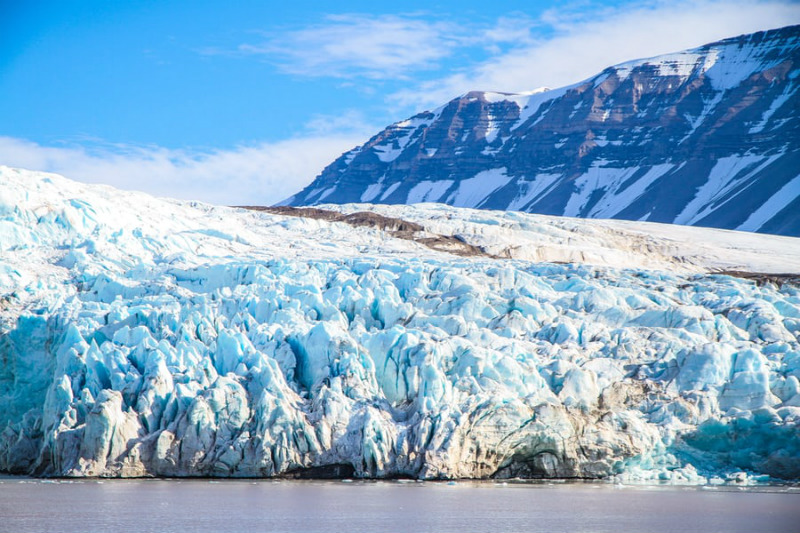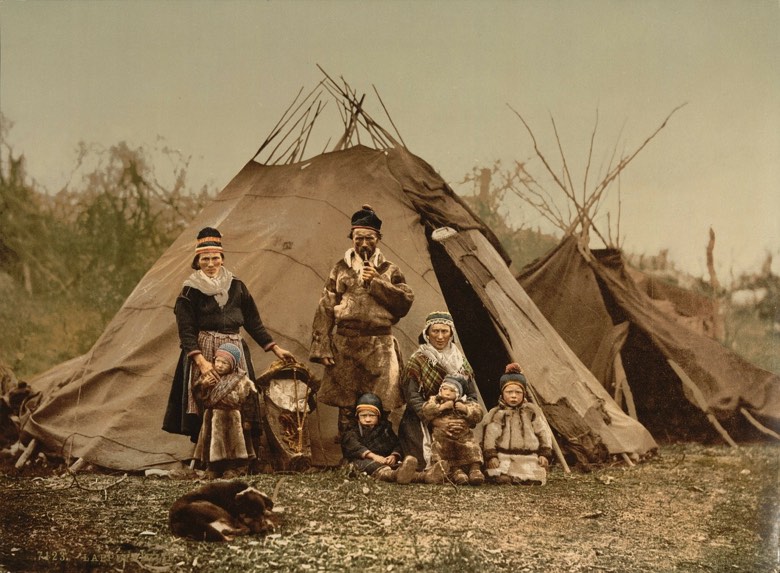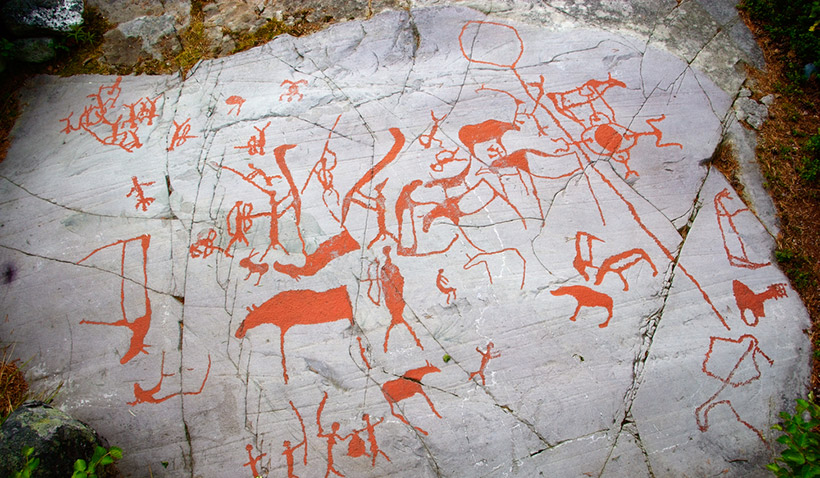There’s so much more to Scandinavian history than longboats and raiders. Let's take a look at what prehistoric Northern Europe was like before the Viking Age changed things forever.
Long before the Vikings set sail, the lands we now know as Norway, Sweden, and Denmark were shaped by ice, populated by resilient settlers, and home to evolving cultures that laid the foundations for the Norse world.

From early hunter-gatherers and complex Bronze Age societies to the enduring indigenous Sami people, the story of pre-Viking Scandinavia is rich, diverse, and deeply connected to the land.
In this article, we trace that journey from the Ice Age to the dawn of the Viking Age. Let's get going.
The Ice Age: Shaping the Scandinavian Landscape
Scandinavia’s dramatic terrain didn’t always look the way it does today. During the last Ice Age, which began around 2.4 million years ago and lasted until approximately 11,500 years ago, massive glaciers covered much of northern Europe.
These immense ice sheets, in some places more than two kilometres thick, extended from the mountains of Norway across vast swathes of what is now Sweden, Denmark, and Finland.
These glaciers were not static masses but dynamic and powerful forces of nature. As snow accumulated year after year, the increasing weight compacted it into dense ice. Under the pull of gravity, this glacial mass began to move, slowly but relentlessly, across the landscape.
The underside of these glaciers, warmed slightly by the pressure and geothermal heat, allowed for a lubricating layer of meltwater that further accelerated their movement.
As they advanced, glaciers scoured the bedrock beneath them, eroding valleys and carrying with them enormous quantities of rock and sediment. Massive boulders, called glacial erratics, were picked up and transported many kilometres before being deposited far from their original location.
One of the most striking examples of this process can be seen in the boulder-strewn fields of Rogaland in western Norway.
The movement of these glaciers carved out deep U-shaped valleys, fjords, and cirques. Norway’s iconic fjords are perhaps the most dramatic legacy of this glacial sculpting. The Sognefjord, for example, plunges to depths of over 1,300 metres and stretches more than 200 kilometres inland.

When the Ice Age ended and the glaciers began to retreat, they left behind a dramatically reshaped landscape. Meltwater filled the newly carved valleys and depressions, forming the countless lakes of Sweden and Finland.
In Denmark and southern Sweden, the retreating ice left behind rolling hills, fertile plains, and rich deposits of soil, making these regions well-suited for the agriculture that would come much later.
These new environments, with their fresh water sources and diverse terrain, created ideal conditions for the first human settlers to move in.
The First Settlers: Mesolithic Cultures in Scandinavia
As the ice sheets melted, small groups of humans moved north to explore and settle the newly exposed lands.
Archaeological evidence suggests that Scandinavia’s earliest inhabitants arrived between 10,000 BC and 8,000 BC. These people were mobile hunter-gatherers, following herds and relying on fishing and foraging.
One of the oldest known individuals from Scandinavia is the Koelbjerg Man, whose remains were discovered in a bog near Odense, Denmark. He lived around 8,000 BC and is believed to have been part of the Maglemosian culture, an early Mesolithic group known for using tools made from flint, bone, and antler.
These early cultures—including the Maglemosian, Kongemose, and Ertebølle peoples—developed regionally distinct ways of life. In Denmark and southern Sweden, they lived near coastlines and wetlands, creating semi-permanent settlements and becoming increasingly skilled in fishing, seal hunting, and woodworking.
Further north in Norway, people gradually moved into coastal areas, living seasonally and adapting to harsher climates.

When the ice melted around 11,500 years ago, it wasn’t just the fjords that were left behind. In the flat, low-lying fields of Rogaland, further dramatic scars of the ice age remain. Here, great rocks look out of place, scattered in random places.
The Sami People: Indigenous Life in the North
Alongside the migration of other groups, a distinct northern culture took shape. The ancestors of the Sami people have lived in the northern parts of Norway, Sweden, Finland, and Russia for millennia, with roots dating back to the early Mesolithic period.
Archaeological evidence connects early Sami populations to traditions such as the Komsa culture in northern Norway and the Suomusjärvi culture in Finland. These groups left behind tools made from stone and bone, traces of seasonal dwellings, and remains of hunting and fishing gear.
These early peoples lived as nomadic hunter-gatherers, expertly navigating the harsh Arctic and sub-Arctic environments. They followed a seasonal migration pattern tied closely to the movements of game animals and the availability of fish.
Their survival depended on deep ecological knowledge, allowing them to exploit the full range of natural resources available in tundra, forest, and coastal regions. While reindeer featured prominently in their lives as a hunted species, domesticated reindeer herding only began to emerge in a limited form around the 9th or 10th century AD.
Culturally and linguistically distinct from their Indo-European neighbours, the Sami developed their own rich oral traditions, spiritual beliefs, and languages belonging to the Uralic family.
Animism and nature worship played central roles in Sami spirituality, with sacred sites such as stones, hills, and lakes acting as portals between the physical and spiritual worlds. The noaidi, or Sami shamans, served as mediators with the spirit world through drumming, chanting, and trance.
Today, the Sami are the only internationally recognised Indigenous people of mainland Europe. In Norway, their population is estimated between 40,000 and 60,000, though exact numbers are difficult due to centuries of assimilation policies.
Despite these pressures, the Sami have retained their cultural identity, particularly in areas such as language, duodji (traditional handicrafts), joik (a form of song), and land-based livelihoods.

Understanding the deep history of Scandinavia requires recognising the Sami not as marginal participants but as a central, enduring presence in the region's prehistory and beyond.
Neolithic Revolution: Farming Comes to the North
Around 4,000 BC, major changes began to reshape Scandinavian societies. The arrival of farming marked the transition from the Mesolithic to the Neolithic period.
This shift was gradual and uneven, occurring first in southern Scandinavia due to its more temperate climate and fertile soils. In areas like Denmark and southern Sweden, people began cultivating crops such as wheat, barley, and flax.
Domesticated animals, including sheep, goats, pigs, and cattle, were also introduced, marking a fundamental change in the relationship between humans and their environment.
The Funnelbeaker Culture (named after their distinctive funnel-shaped pottery) played a key role in this agricultural transition. These people constructed monumental megalithic tombs using massive stones, an indicator of increasing social organisation and communal effort.
Sites like Ale's Stones in Sweden and the dolmens of Zealand in Denmark remain as visible reminders of their legacy. These tombs were not merely burial sites but also spiritual and territorial markers, reflecting emerging beliefs and the anchoring of communities to specific lands.
Farming allowed for a more sedentary lifestyle, enabling the development of permanent settlements, surplus food production, and more complex social structures.
This, in turn, contributed to population growth, the development of hierarchical societies, and eventually the division of labour. However, this agricultural way of life did not spread uniformly across Scandinavia.
In coastal areas and the far north, hunting and gathering remained dominant for many centuries. These regions were less hospitable to early agriculture due to their harsher climates and rugged landscapes.
The Pitted Ware Culture, which emerged around 3,200 BC, represented a blend of lifestyles: they adopted some Neolithic tools and pottery while maintaining a strong reliance on fishing, seal hunting, and foraging.
In many places, they lived alongside or in succession to Funnelbeaker communities, creating a diverse cultural mosaic during the Neolithic.
Nordic Bronze Age: Trade, Ritual, and Social Change
The period from about 1,700 BC to 500 BC marks the height of the Nordic Bronze Age, a time of significant innovation, increased connectivity, and social transformation.
Although Scandinavia had no indigenous sources of copper or tin, the essential ingredients of bronze, it became deeply involved in long-distance trade networks. Amber from the Jutland Peninsula was particularly prized and has been found as far afield as Mycenaean Greece, indicating the vast reach of Nordic traders.

With the arrival of bronze technology, Scandinavian societies entered a new era of craftsmanship and cultural expression. Metalworkers produced elaborately decorated swords, axes, jewellery, and ceremonial objects, some of which were likely status symbols or ritual offerings.
Settlements remained relatively small but were often centred around extended family units living in large wooden longhouses, which became a defining architectural feature of the region.
Agriculture remained central to Bronze Age life, with barley, wheat, and millet cultivated in lowland fields. Livestock such as pigs, sheep, and cattle provided meat, hides, and milk. Communities along the coasts also relied heavily on fishing and shellfish harvesting, taking advantage of the maritime environment.
Religion and ritual practices flourished during this era. Thousands of petroglyphs—rock carvings—have been discovered across southern Scandinavia, particularly in Bohuslän and Østfold.
These carvings depict scenes of ships, warriors, animals, and solar imagery, suggesting a belief system focused on the sun, seasonal cycles, and fertility. Ritual offerings of weapons, ornaments, and even entire wagons have been unearthed from bogs and lakes, thought to be gifts to deities or spirits of the land and water.
Burial practices became more formalised and stratified. Individuals of higher status were interred in large burial mounds, often with bronze weapons, gold jewellery, and ornate clothing, reflecting their wealth and importance.
These elite burials demonstrate increasing social complexity and the emergence of local chieftains or tribal leaders who controlled trade and resources, setting the stage for the political structures of the Iron and Viking Ages to come.
Iron Age: Foundations of Norse Culture
The Iron Age in Scandinavia spans from around 500 BC to the beginning of the Viking Age around 800 AD. It is often divided into several phases, including the Pre-Roman Iron Age, Roman Iron Age, Migration Period, and Germanic Iron Age.
Iron tools and weapons became widespread, transforming agriculture, warfare, and daily life. Unlike bronze, iron was accessible locally, particularly from bog iron deposits in Denmark and Sweden. This shift reduced dependence on long-distance trade and enabled more self-sufficient communities.
In Norway, Iron Age settlements grew along the coasts and in the fertile lowlands. The longhouse remained the dominant form of housing. Societies became more stratified, and evidence of local kings and warrior elites begins to emerge, especially during the later Germanic Iron Age.
Cultural exchange with the Roman Empire had a lasting impact. Roman coins, glassware, and weapons have been found in southern Scandinavia, suggesting extensive trade and possibly mercenary service in the Roman legions.
New burial styles, such as stone ship settings and cremation graves, also appear during this time.
By the 6th and 7th centuries, oral storytelling traditions, artistic motifs, and religious beliefs that would later define the Viking Age were already taking shape. The mythology, runic writing, and warrior ethos attributed to the Vikings have their roots deep in the Iron Age.
The Viking Age looms large in the popular imagination, but it was merely the latest chapter in a long and dynamic history.
From Ice Age hunters and early farmers to Bronze Age traders and Iron Age chiefs, the peoples of Scandinavia adapted, innovated, and thrived in a challenging environment.


You mean the Sami weren’t reindeer *herders* until much more recently. Before that, they were reindeer *hunters.*
So I read that the people just before the Vikings wore the hats with horns. Any truth to that?
I read somewhere recently that the horned helmets were a Hunnish thing, not Scandinavian.
There is no evidence of Vikings wearing helmets with horns, nor the norse before them. This is a popular culture myth from the last 150 years or so.
You bet. Fun fact one of the first kings and queens were tribal leaders too. Amazing article read.
Thank you for this account !
I just wonder why your article did not make a clear distinction between the “ur befolkning” aboriginal Scandinavians and the new comers indoEuropeans(invadors) ?
If we look a bit closer to the historical accounts and Nors methology; the time before the viking period was not pleasant and quiet at all.
The instalation of the indo-Europeans in Scandinavia was indeed a long hell nightmare for the aboroginals of Scandinavia. The people have been reduced to slavery, their languages vanished their cultures erased….and their Gods have become either evils or reduced as second classe Gods ( Luk, Freie etc).
A very quick analysis of the Nors methodology..
and you will understand that all the invaders Gods were great (Tor, …) and the aboriginals’ Gods recuded to second rang. The people that resisted in the mountains and fight against the indo-Europe invadors; they have been pictured as awful and called Trolls …. and still do.
Well it is a long story….
Can you recommend a good book on this?
I read, in various sources, about large groups of peoples from the Middle East migrating to Scandinavia prior to and around 8000 BC. Any information about this???
My great grandmother came from SW Sweden in 1894. My great grandfather’s parents came from an area near Stockholm in 1869. When I did my
DNA it shows that I am more Norwegian than Swedish. How did that happen?
My Ancestors started out in Finland and Northern Russia and then to Germany and then to France and then to England and then to Ireland and then to Canada were I’am now
I am giving a talk about my trips to Norway tomorrow and I came across this article. I might add some of what I learned.
All my grandparents came from Norway but I was the first one to visit Norway and have visited family from both sides of the family.
Thank you for this gift of new knowledge.
J. Paez